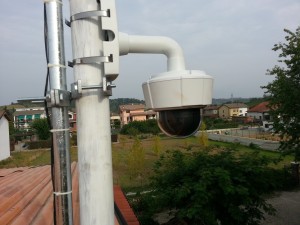
Hollywood has created a glamorized view of PTZ cameras and how they operate. People who have seen PTZs or pan, tilt, zoom cameras in movies are often enchanted by them. They are “cool” cameras to say the least, and therefore initially people often think that this is what they want to meet their surveillance needs. However, that is not always the case. While PTZs are great cameras when used for the correct application, it’s important to be informed on their pros, cons, and uses before deciding.
What are the benefits of PTZ cameras?
- Monitoring large areas: PTZ cameras are designed to cover very large areas such as farms, malls, parking lots, etc. It’s ability to pan, tilt, and zoom allows it to cover far more space than a traditional fixed camera. Typically these cameras are used to survey an area that would be too expensive or impossible to cover with fixed cameras
- Manually controlling cameras: with PTZs, personnel have the ability to look at exactly what they what, when they want. If an event occurs in a certain location and the offender takes off running this camera would allow the viewer to zoom in on his face and track him AS HE RUNS.
- Available Tours: A tour is a pattern that the PTZ camera follows on a specified schedule. For example: the camera could be set so that it’s constantly in a rotating pattern of looking at the gate, then an outbuilding, and then another entrance. This automated tour is an advantage from the standpoint that no one needs to be present in order to get these views.
A demo of a PTZ camera in action:
What is the primary downside of PTZ cameras?
- Limited View: The major downside of PTZ cameras is their inability to record areas that the camera is not specifically looking at. For example, if the viewer moves the camera to view a certain location and an incident occurs somewhere else, the PTZ has no ability to capture that event. It is nice that it can be maneuvered but the downside is that it can’t see everything at once.
For some, the camera application isn’t so cut and dry – “How can we have the ability to move our camera around but still have some coverage where the PTZ isn’t looking?” The answer is to utilize both a PTZ camera and several strategically placed fixed cameras, allowing for mobility without neglecting key locations. For example, pretend that you want surveillance at a large facility that has two major gate entrances and then two entrances going inside the building. In order to effectively monitor this location it would be best if fixed cameras were strategically placed at these entrances and gates (and possibly other key locations as well) with the ability to get facial recognition and license plate tags. Once key locations have been covered with fixed cameras, a PTZ camera could be added in order to survey the large facility. If an event is seen with the PTZ but the face is not recognizable then the viewer could look at one of the fixed cameras at the entrances to possibly indentify the suspect. A combination of PTZ and fixed cameras can provide a robust surveillance system.
If you’re still unsure which type of surveillance camera is best for your business, contact our security experts at Security Alarm. Our team will be happy to answer your questions and help determine which solution is best for your needs.

